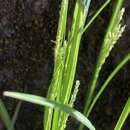Comments
provided by eFloras
Plants with glabrous leaves and sheaths are occasionally found and have been treated as Carex oxylepis forma glabra Kükenthal; plants with perigynia pubescent, in addition to normally pilose leaves and sheaths, have been treated as C. oxylepis var. pubescens. Taxonomic recognition is not warranted in either case because the traits vary within populations and are not correlated with other structural differences.
- license
- cc-by-nc-sa-3.0
- copyright
- Missouri Botanical Garden, 4344 Shaw Boulevard, St. Louis, MO, 63110 USA
Description
provided by eFloras
Plants densely cespitose. Culms dark maroon at base; flowering stems 25–80 cm, usually longer than leaves at maturity, 1–2 mm thick, glabous to pubescent. Leaves: basal sheaths maroon, bladeless, pubescent, sometimes glabrous, others grading from maroon to green on back, light brown-hyaline on front, dotted or streaked with dark red, pubescent distally; blades flat, 3–7 mm wide, pilose, especially abaxially, sparsely so distally, margins ciliate. Inflorescences: peduncles of lateral spikes slender, 5–20 mm, shorter than spikes, pubescent; peduncle of terminal spikes 5–40 mm, minutely scabrous; proximal bracts nearly equaling but usually not exceeding inflorescences; sheaths 15–25 mm; blades 1.5–3 mm wide. Lateral spikes 2–4, 1 per node, distal 2 usually overlapping terminal spike, others well separated, nodding or drooping at maturity, pistillate with 20–45 perigynia attached 1.5 mm apart, narrowly cylindric, 15–45 × 3–4.5 mm. Terminal spike gynecandrous, 15–45 × 2–4.5 mm. Pistillate scales hyaline with broad green, red dotted midrib, elliptic-ovate, shorter than mature perigynia, apex acute to aristate or awned, awn less than 1 mm, ciliate. Perigynia green to dark olive-green, copiously red dotted, 2-ribbed with 6–10 almost equally prominent veins, loosely enveloping achenes, ellipsoid-ovoid, 3.5–5 × 1.7–2 mm, membranous, base acute or with short stipe, apex gradually tapered to beak, glabrous or less often pubescent; beak minutely bidentate, 0.4–0.7 mm. Achenes distinctly stipitate, 1.7–2.5 × 1–1.5 mm, stipe to 0.7 mm.
- license
- cc-by-nc-sa-3.0
- copyright
- Missouri Botanical Garden, 4344 Shaw Boulevard, St. Louis, MO, 63110 USA
Habitat & Distribution
provided by eFloras
Fruiting late spring–early summer. Floodplain forests, rich, moist deciduous forests, near streams or in swampy areas, upland forests on sandy soils, wooded bluffs, often associated with calcareous soils; Ala., Ark., Fla., Ga., Ill., Ky., La., Miss., Mo., N.C., Okla., S.C., Tenn., Tex., Va.
- license
- cc-by-nc-sa-3.0
- copyright
- Missouri Botanical Garden, 4344 Shaw Boulevard, St. Louis, MO, 63110 USA
Comprehensive Description
provided by North American Flora
Carex oxylepis Torr. & Hook. ; Torr. Ann. Lye. N. Y 3:409. 1836.
Carex familiaris Steud. Syn. Cyp. 226. 1855. (Type from the Rio Brazos, Texas.) Carex oxylepis var. Bock. Linnaea 44: 408. 1876. (From South Carolina.)
Carex oxylepis f. glabra Bock.; Kiikenth. in Engler, Pflanzenreich 4 20 : 589. 1909. (Type from South Carolina.)
Cespitose, from slender but tough blackish rootstocks, the clumps medium-sized, the culms 2.5-8 dm. high, slender, from shorter to longer than the leaves, aphyllopodic, sharply triangular, glabrous to slightly pubescent on the angles, strongly purple-tinged at base, the lower sheaths sometimes breaking and becoming filamentose; leaves 3-5 to a culm, not septatenodulose, evenly separated on the lower half, the blades ascending, flat, thin, deep-green, soft, 1-3 dm. long, 3-6 mm. wide, more or less hairy, especially on the under surface, the sheaths long, more or less hairy, hyaline ventrally, concave at mouth, the ligule nearly as long as wide; terminal spike gynaecandrous, the lower two thirds staminate and with few to several pistillate flowers above, peduncled, 1.5-3.5 cm. long, the staminate portion 1-2 mm. wide, the scales oblanceolate, acuminate or short-cuspidate, rather loose, white-hyaline with green midrib; pistillate spikes 2 or 3, somewhat separate, erect or more or less drooping, on slender, slightly hairy peduncles usually shorter than the spikes, the spikes linear-cylindric, 1.5-4.5 cm. long, 3-4 mm. wide, closely (or more loosely at base) 15-40-flowered, in several rows; bracts from shorter to somewhat longer than the culm, strongly sheathing, the lower leaf-like, the upper reduced; scales narrowly ovate, acuminate, cuspidate, or short-awned (the upper acuminate or short-cuspidate), greenish-white, with 3-ribbed green center, scabrous above, narrower and shorter than the perigynia; perigynia ascending, elliptic-lanceolate, 3.5-4 mm. long, 1.75-2 mm. wide, triangular-suborbicular in cross-section, scarcely inflated, glabrous, membranaceous, deep-green, puncticulate, strongly several-nerved, round or round-tapering at base, substipitate, round-tapering and short-beaked at apex, the beak shallowly bidentate; achenes obovoid, 2 mm. long, 1.5 mm. wide, triangular with concave sides and blunt angles, granular, yellowish, in lower half of perigynium, rather closely enveloped, minutely substipitate, apiculatetipped, jointed with the straight slender style; stigmas 3, very short, brownish-black.
Type locality: "Texas, T. Drummond. (Texas collection III. no. 436)."
Distribution: Rich woods, Texas to Florida, and northward to southeastern Missouri, Tennessee, and Virginia. (Specimens examined from Florida, Georgia, South Carolina, North Carolina, Alabama, Tennessee, Mississippi, Louisiana, Texas, Arkansas, southeastern Missouri.)
- bibliographic citation
- Kenneth Kent Mackenzie. 1935. (POALES); CYPERACEAE; CARICEAE. North American flora. vol 18(5). New York Botanical Garden, New York, NY

